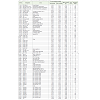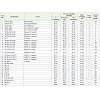Identification of New Sources of Resistance against Brown Plant Hopper
Neha Bhatt and SN Tiwari*
Corresponding author: Dr. SN Tiwari, Department of Entomology, G.B. Pant University of Agriculture and Technology,Pantnagar-263145 (U.S. Nagar), Uttarakhand, India;E-mail: drsntiwari@gmail.com
Department of Entomology, G.B. Pant University of Agriculture and Technology, Pantnagar-263145 (U.S. Nagar),Uttarakhand, India
Citation: Bhatt N, Tiwari SN . Identification of New Sources of Resistance against Brown Plant Hopper. J Plant Sci Res. 2015;2(2): 126.
Copyright © 2015 SN Tiwari et al. This is an open access article distributed under the Creative Commons Attribution License, which permits unrestricted use, distribution, and reproduction in any medium, provided the original work is properly cited.
Journal of Plant Science & Research | ISSN: 2349-2805 | Volume: 2, Issue: 2
Submission: 25/06/2015; Accepted: 10/07/2015; Published: 16/07/2015
Abstract
One hundred twenty rice genotypes belonging to Plant Hopper Screening (PHS) and Multiple Resistance Screening Trials (MRST) received from AllIndia Co-ordinated Rice Improvement Programme (AICRIP) during kharif 2013 were evaluated against Brown Plant Hopper under glasshouse conditionsat G.B.P.U.A.T. Pantnagr. During present study RP 2068-18-3-and CR3006-8-2 were found resistant while 10 other entries were recorded as moderatelyresistant against this insect in PHS. Under MRST none of the entries showed resistant reaction however RP 4918-228(S) and PTB33 showed moderate levelof resistance against BPH.
Keywords: Bio-stimulant; Protein hydrolysate; Amino acids; Peptide; Growth; Yield
Introduction
Brown plant hopper (BPH), Nilaparvatalugens (Stal.)(Homoptera: Delphicidae) is a major pest of rice in several countries[1-3] where it cause 30-50% loss in yield [4,5]. Although, insecticidesare used to control it in most of the agro-ecosystem, resistance in therice genotype has been found to play significant role in reducing thepopulation [6-8] and a number of varieties resistant to this insectpest are now available for commercial cultivation in many countriesincluding India [9]. Substantial progress has been made in the area ofevaluation of rice entries for resistance, however, promising varietiesare not available for each and every agro-ecosystem including taraiand plains of Uttrakhand which are most frequently attacked by thispest. The present study was undertaken to identify the new sources ofresistance against BPH so that resistant varieties could be developedfor this region.
Material and Method
One hundred twenty entries ofPlant Hopper Screening trial (PHS)and Multiple Resistance Screening trial (MRST) received under AllIndia Co-ordinated Rice Improvement Programme (AICRIP) kharif2013were evaluated against brown plant hopper. In PHS PTB33 andRP 2068-18-3-5 were used as resistant check while TN1 was taken assusceptible check. In case of MRST Suraksha and PTB 33 were used asresistant check while TN1 was treated as susceptible check.
The adults of BPH were collected from stock culture maintainedin glasshouse on TN1 since 2011. The stock culture was developed inaluminium rearing cages (200 Χ 80 Χ 92 cm) fixed with insect proofnylon net and glass. Approximately 10-15 adults were transferred on50-60 days old potted plants of Taichung Native-1 (TN-1), placed inrearing cages. After one week adults were removed from pots. Thecages were examined regularly for the presence of predators and other insect species. Whenever the predators or other species ofinsects were observed in the cages, they were removed to facilitate thedevelopment of BPH population.
Seed bed screening method was used for bulk screening of entries.The purpose of bulk screening was to reject the susceptible onesand to find out entries showing moderate to high level of resistanceagainst BPH. All the screening tests were done in plastic tray size of42cmx32cmx7cm in glasshouse.
Plastic petridishes were marked with respective entry numberand fifty seeds of each entry were kept on double layered moist filterpapers. Water was added to each petridish for seed soaking which wasremoved after 24 h. Thereafter, petridishes were placed in incubatormaintained at 30 °C temperature for efficient germination.
The germinated seeds of each test entry were sown in the tray(42cmx32cmx7cm) with the help of forceps. Each tray was having 17rows of different entries. Twenty pre-germinated seed was sown ineach row and labelled. The distance between the rows was maintainedat 2 cm apart, while distance between seeds was kept at 1 cm. Ninerows of entries were alternated with one row of susceptible check TN1. After completing the sowing sufficient water was added to ensurethe healthy growth of seedlings. At 12 days after sowing (DAS) traywas filled with 5 cm water level and each row was thinned to about20 seedlings / row after which the 2nd and 3rd instar nymphs of BPHfrom the culture were distributed uniformly on the test entries at therate of approximately 10 nymphs per seedling. Number of dead andsurviving plant of each entry was counted at two day interval. The final score was taken when the seedlings of susceptible check varietyTN-1 became 100 percent dead. The rating was based on the followingscoring system:
Rating scale
In the above rating scale particulars in ‘scale’ ‘and level ofresistance’ were taken from [9] but the ranges for percent deadseedlings were constructed to facilitate the rating based on percentseedling mortality due to BPH damage.
Scale | Percent dead seedlings | Level of resistance |
0 | 0 | Immune (I) |
1 | 1-5 | Highly resistant (HR) |
3 | 6-9 | Resistant (R) |
5 | 10-25 | Moderately resistant (MR) |
7 | 26-60 | Moderately susceptible (MS) |
9 | 61-100 | Susceptible (S) |
Results and Discussion
In Plant Hopper Screening trial (PHS) mean seedling mortalityvaried from 7.5 to 100 percent among 90 entries screened [Table 1].Breeding lines RP 2068-18-3-and CR 3006-8-2 recorded 7.5 percentseedling mortality and rated as resistant against BPH. Moderate levelof resistant (MR) was observed in RP 5320-124-10-1-2-2-1, IR 65482-7-216-1-2-B, CR 2711-149, CR 2274-3-1-2-1-1, KAUM 179-1, KAUM179-4, KAUM 182-1, TRG 170 and KNM 124 which showed 15 to 25percent seedling mortality. The rest of the entries were moderatelysusceptible or susceptible against brown plant hopper.
These results were in accordance with multilocation trials ofAICRP [10] where breeding lines viz., IR 65482-7-216-1-2-B, CR2711-149, KAUM 179-1 and KAUM 182-1were reported as promisingwhile tests entry CR 3006-8-2 reported resistant.
In the Multiple Resistance Screening trial (MRST) only onebreeding line RP 4918-228(S) showed moderate level of resistance inwhich mean seedling mortality was 20 per cent. Resistant check PTB33 also showed moderate level of resistance. Rest of the 28 entries showed 33.75 to 100 per cent mortality and exhibited moderatesusceptibility to susceptible reactions against BPH presented in Table 2. These results were in confirmation with trial conducted at Ludhianain greenhouse where RP Bio 4918-228(S) was identified as promisingwith a mean damage score of 1.5 [10].
Conclusion
Results indicate that among all genotype screened CR 3006-8-2 and RP 2068-18-3-5 were found to be promising against brownplant hopper at Pantnagar and could be used in developing resistantvarieties against BPH for tarai region of Uttrakhand.
Acknowledgement
Authors are highly thankful to Indian Institute of Rice Research Hyderabad for providing the PHS and MRST entries for experimental purpose.
References
- Dyck VA, Thomas B (1979) The brown planthopper problem. In: Brown planthopper: threat to rice production in Asia. International Rice Research Institute, Manila (Philippines): 3-17.
- Huang Z, Shu L, Li X, Zhang Q (2001) Identification and mapping of two brown planthopper resistance genes in rice. Theor Appl Genet 102: 929-934.
- Yang HY, Ren X, Weng QM, Zhu LL, He GC (2002) Molecular mapping and genetic analysis of a rice brown planthopper (NilarparvatalugensStål) resistance gene. Hereditas 136: 39-43.
- Pathak PK, Verma SK, Lal MN (1983) Occurance of insect pests of rice.Directorate of Experiment Station, GB Pant University of Agriculture and Technology, Pantnagar: 69-71.
- Sogawa K, Cheng CH (1979) Economic thresholds, nature of damage, and losses caused by the brown planthopper. In: Brown planthopper: threat to Rice production in Asia. International Rice Research Institute,Manila (Philippines): 125-144.
- Pathak MD, Dhaliwal GS (1986) Insect control. In: MS Swaminathan and SK Sinha (eds.). Global aspects of food production. Tycooly International, Oxford, UK: 357-386.
- Dhaliwal GS, Dilawari VK, Saini RS (1993) Host plant Resistance to insects: Basic concepts. In : G.S. Dhaliwal and V.K.Dilawari (eds.). Advances in Host Plant Resistance to Insects. Kalyani publishers, New Delhi, India :1-30.
- Dhaliwal GS, Dilawari VK (1996) Host plant resistance in integrated pest management. In: RK Upadhayay, KG Mukherjee and RL Rajak (eds.). IPM System in Agriculture. Vol 1 Aditya Books Pvt. Ltd., New Delhi, India: 264-315.
- Heinrichs EA, Medrano FG, Rapusas HR (1985) Genetic evaluation for insect resistance in rice. IRRI, Los Banos, Philippines 356.
- Anonymous (2013) Progress Report 2013 Vol 2. Entomology and Pathology. All India Co-ordinated Rice Improvement Pogramme. Directorate of Rice Research, Hyderabad, India.


